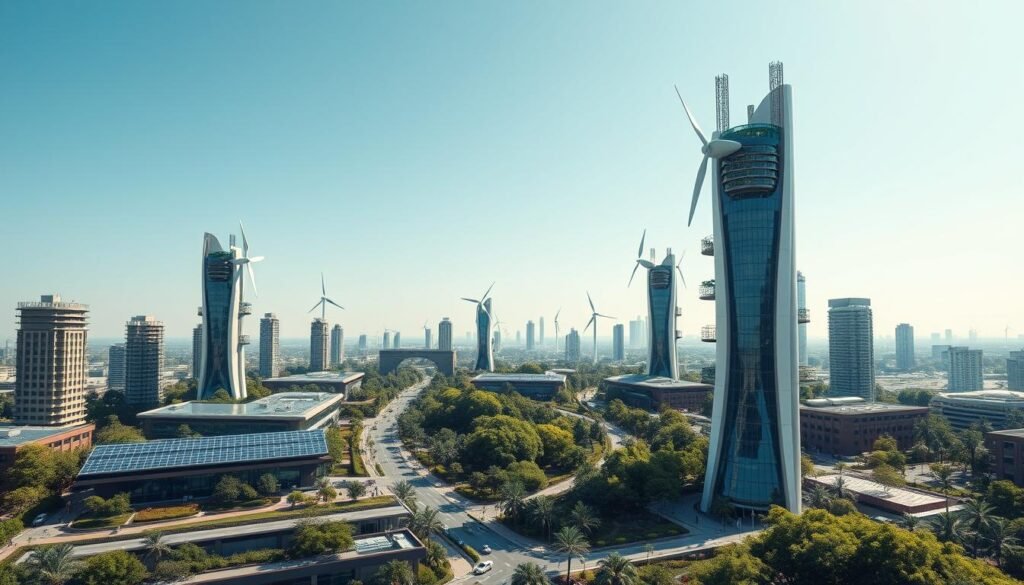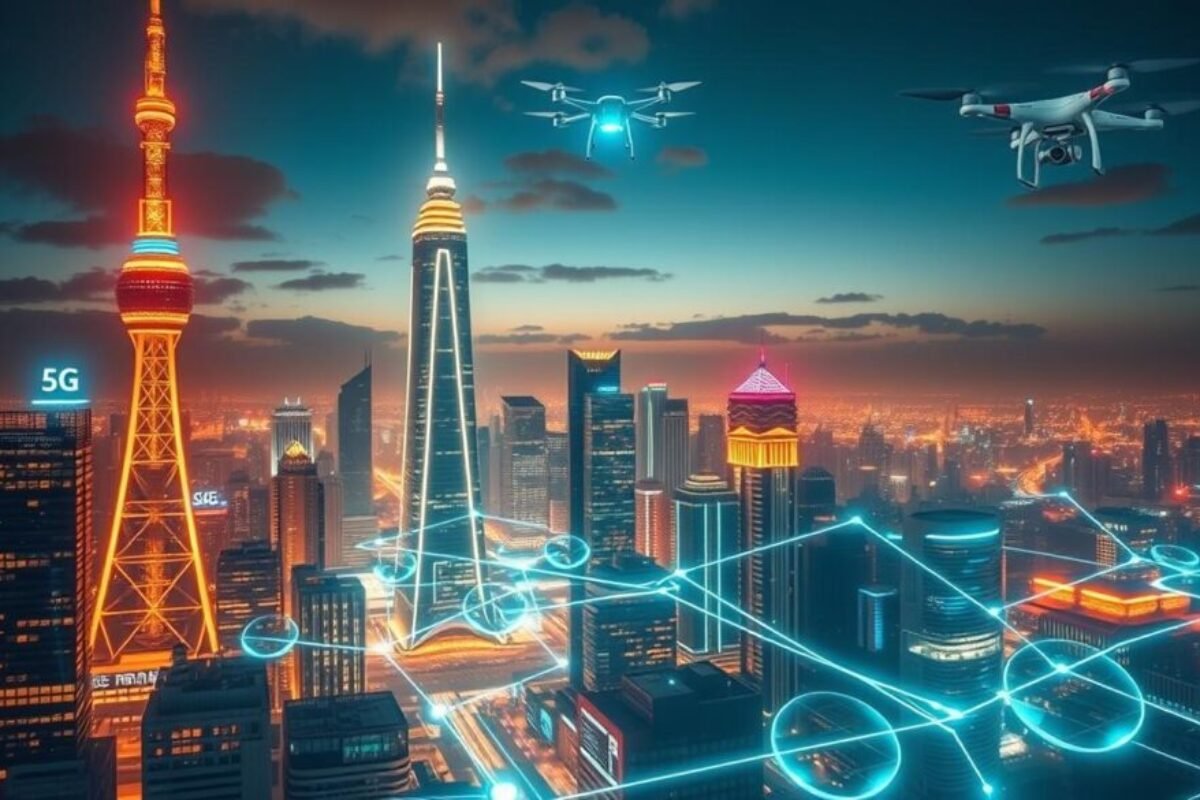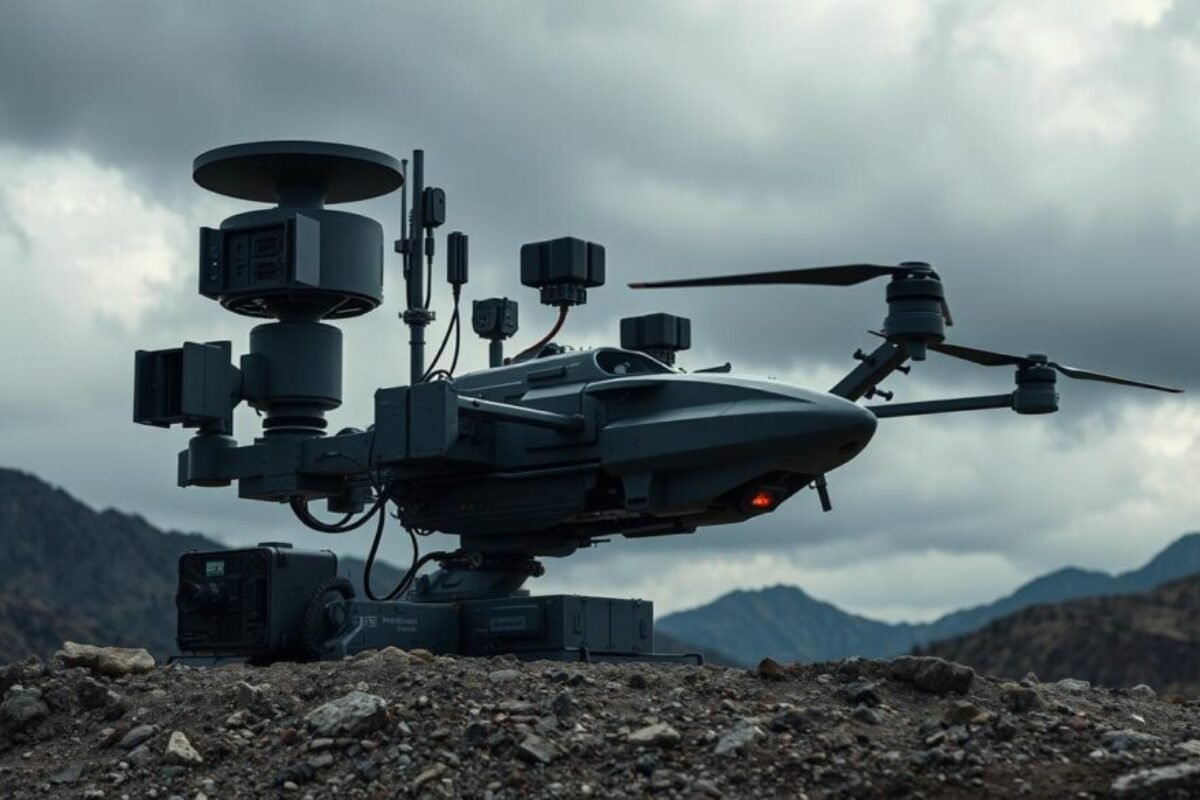How 5G Technology is Powering Digital Innovations Everywhere
5G technology is changing how we live and work. It started hitting the market in late 2018 and will grow worldwide1. This technology offers up to 100 times more capacity than 4G, making it a game-changer for cities, factories, and private networks1.
Exploring 5G technology shows its power to drive digital innovation. It can reach speeds of up to 20 Gbps, much faster than 4G’s 100 Mbps1. Latency is also greatly reduced, to as low as 1 millisecond1. This means a smoother and more efficient experience. It will impact many industries, from healthcare to entertainment, and boost economic growth.
Looking at 5G adoption, 62% of Americans have access to high-speed 5G at home1. This suggests widespread adoption is near. Combining 5G with other emerging technologies will unlock its full power.
Key Takeaways
- 5G technology is expected to grow at 350% over the next 5 years2.
- 5G can provide up to 100 times more capacity than 4G, enabling various applications across cities, factories, and private networks1.
- 5G speed can reach up to 20 Gbps, a significant increase from 4G speeds of up to 100 Mbps1.
- Mobile Internet traffic is estimated to grow over 40% a year by 20252.
- The most promising use cases of 5G could increase the global GDP by between $1.2 trillion and $2 trillion by 20303.
Understanding the Evolution of 5G Technology
The journey of 5G technology has changed how we talk and connect with the world. With 5g network and 5g wireless tech, speeds, latency, and connectivity have greatly improved4. shows 5G can reach speeds of 20 Gbps, compared to 4G’s 1 Gbps. Latency has also dropped to 1-2 milliseconds, down from 20-70 milliseconds in 4G.
5G can handle many more devices than 4G, making it great for IoT devices5. This has led to smart cities, self-driving cars, and remote healthcare. To work, 5G uses millimeter wave tech, which needs more small cells to get around obstacles5.
The benefits of 5G are vast, from connected cars to smart wearables and VR/AR. It also brings fast internet to rural areas and makes transportation safer6. As we move to 5G, we’ll see growth in areas like virtual reality, telemedicine, and smart manufacturing6.
In summary, 5G’s evolution has been incredible, impacting many industries. As we keep improving 5g network and 5g wireless tech, our lives will get better and more connected.
| Generation | Peak Download Speed | Latency |
|---|---|---|
| 4G | 1 Gbps | 20-70 milliseconds |
| 5G | 20 Gbps | 1-2 milliseconds |
The Infrastructure Behind 5G Networks
The 5G network infrastructure is complex and requires high-speed data, low latency, and high capacity7. A dense network of small cells and edge computing are key8. Building this infrastructure costs a lot, with estimates over $2.7 trillion by 20207.
Challenges in 5G infrastructure include frequency, deployment, cost, regulations, and security7. Companies are finding solutions like network slicing and private 5G networks8. For instance, Nokia updated five million tower radios to 5G with a software update8.
The role of 5G infrastructure is vital for applications like smart cities and autonomous vehicles7. Investing in 5G infrastructure is essential, despite the challenges and costs7.
In conclusion, 5G network infrastructure is a key part of the 5G ecosystem7. Its development and deployment will greatly impact future telecommunications7. We must keep innovating and investing in 5G infrastructure to reach its full promise8.
Core Components of Modern 5G Architecture
The modern 5G architecture is built for high speeds, low latency, and high capacity. It includes small cell technology, Massive MIMO, and edge computing. Small cell tech lets us use smaller, more flexible base stations for better coverage9. Massive MIMO boosts network capacity and performance with multiple antennas10.
Edge computing is key for 5G, processing data closer to users for faster performance. This is vital for apps needing quick processing, like self-driving cars and virtual reality11. The 5G core network uses cloud technology for security and session management, ensuring it works well with other networks worldwide10.
5G architecture supports many applications, from fast mobile internet to critical communications. It offers faster data transfer, lower latency, and better connectivity. Key features include network slicing, cloud-native deployment, and edge computing1011.
- Network slicing, which enables operators to create virtual slices customized for specific use cases or service demands10
- Cloud-native deployment principles, which leverage virtualization, containerization, and microservices architectures for enhanced flexibility and scalability10
- Edge computing integration, which enables data to be processed closer to the user, reducing latency and improving performance11
The core of 5G architecture is built for high performance. It uses small cell tech, Massive MIMO, and edge computing. These features ensure 5G networks meet the needs of next generation technology and fast data transfer9.
| Component | Description |
|---|---|
| Small Cell Technology | Enables the deployment of smaller, more flexible base stations |
| Massive MIMO Implementation | Allows for the use of multiple antennas to improve capacity and performance |
| Edge Computing Integration | Enables data to be processed closer to the user, reducing latency and improving performance |
Speed and Latency Advantages of 5G
5G technology has brought a big change in internet speeds. Now, we can enjoy ultra-fast internet like never before. 5G can go up to 10 gigabits per second (Gbps), which is 10 to 100 times faster than 4G12.
This speed is great for apps that need fast data transfer and low latency. Examples include virtual reality, augmented reality, and critical communications.
The latency of 5G is also very low, at just 1 millisecond (1 ms). This is much faster than 4G’s 200 milliseconds12. This low latency is perfect for real-time services like autonomous vehicles and virtual reality gaming.
It also works well for remote surgeries and simultaneous translating. Plus, 5G networks can handle at least 100 times more devices than 4G networks. This makes them great for big IoT applications12.
Some of the key benefits of 5G include:
- Ultra-fast internet speeds of up to 10 Gbps
- Low latency rate of just 1 ms
- Support for a large number of connected devices
- Real-time interactivity for services like autonomous vehicles and virtual reality gaming

Overall, 5G’s speed and latency make it perfect for many uses. This includes everything from entertainment to industrial IoT and critical communications13.
Real-World Applications in Smart Cities
5g connectivity is changing urban infrastructure in big ways. It allows for a huge number of devices to connect in one area. This is key for smart cities and industrial uses14. It makes cities more livable and better at meeting citizen needs.
5G is used in many ways in smart cities. For example, it helps manage traffic and keeps public areas safe. It also helps in urban planning. In traffic management, 5G sensors track traffic live, helping reduce congestion and improve air quality14.
5G also helps in power grids, leading to energy savings and less waste. This could help lower carbon emissions and meet green goals14.
Connected public transport is another big use of 5G, with 74 percent adoption in cities15. Seoul’s public transit system saw a big jump in ridership, from 30 percent to 70 percent, thanks to smart apps15. 5G’s speed and capacity make these improvements possible, making city services better and cheaper than before16.
Healthcare Transformation Through 5G Connectivity
The healthcare industry is changing fast with 5g wireless technology. It gives medical staff a reliable network for their devices, solving Wi-Fi problems in hospitals17. This makes communication and data sharing smooth, key for remote care and personalized treatments.
Private 5g networks are perfect for high-stakes tasks like remote surgeries and virtual reality18. They also support video calls with patients at home. Plus, they use special frequencies for constant access without worrying about costs18.
Some big uses of 5g in healthcare are:
- Remote health monitoring
- Telemedicine
- Personalized medicine
- Internet of Medical Things (IoMT) applications, like smart sensors for vital signs18
Using 5g, healthcare can do better, make patients happier, and save money. With 92 percent of healthcare providers aiming for better patient experiences18, 5g is key in healthcare now.
| Application | Description |
|---|---|
| Remote health monitoring | Enables healthcare professionals to monitor patients remotely, reducing the need for hospital visits |
| Telemedicine | Allows patients to consult with healthcare professionals remotely, improving access to care |
| Personalized medicine | Enables healthcare professionals to tailor treatment plans to individual patients’ needs, improving outcomes |
Industrial Internet of Things (IIoT) and 5G Integration
The mix of IIoT and 5G is big news for the industrial world. It connects many devices and apps. This combo boosts efficiency, productivity, and smart decision-making19. says IIoT in manufacturing adds smart sensors and robots. This makes production better and cuts downtime.
The 5G network is key here, giving fast and reliable internet20. notes 5G is much faster than 4G. It lets us watch and control industrial devices live. This means better work and less time lost.
IIoT and 5G are used in many ways, like:
- Manufacturing automation
- Predictive maintenance
- Supply chain optimization
These uses can change the game for industries. With 5G, IIoT can manage logistics better, using real-time data on traffic and weather20.
In short, IIoT and 5G together could change the industrial world. 5G’s fast and reliable internet lets us control devices in real-time. This boosts work quality and cuts downtime19. also points out 5G makes sensor data better by combining it fast for accurate insights.
| Application | Benefit |
|---|---|
| Manufacturing automation | Improved efficiency and productivity |
| Predictive maintenance | Reduced downtime and improved maintenance |
| Supply chain optimization | Improved logistics and reduced costs |
5G’s Impact on Autonomous Vehicles
The use of 5G in cars is changing the game for the auto world. It brings next generation technology that makes driving safer, more efficient, and connected. With 5G, cars can talk to each other and their surroundings instantly. This cuts down on how long it takes to react and makes driving safer21.
This tech also helps make cities smarter. It makes traffic flow better and lowers the number of accidents21.
Some big pluses of 5G in cars are:
- It lets cars communicate and react fast22
- It has lots of bandwidth for sending big data22
- It can handle lots of devices at once22
As we keep working on next generation technology for cars, we’ll see big gains in safety, efficiency, and connection. With 5G, the future of cars is full of endless possibilities23.

Revolutionizing Entertainment and Media
The entertainment and media world is changing fast, thanks to ultra-fast internet. With 5G, streaming is smoother, with fewer interruptions. This is changing how we watch entertainment24. To make this work, creators, networks, and tech companies must work together25.
5G brings many benefits to entertainment and media. It makes VR and AR better with its fast speeds and low delay25. It also lets us stream sports live with less lag and better quality25. As 5G grows in 2024, it will make media and entertainment even more available26.
Some cool uses of 5G in entertainment and media include:
- Mobile gaming gets better with fast speeds and low delay
- VR and AR become more real and fun
- Streaming sports live becomes smoother and clearer
In short, the entertainment and media world is on the verge of a big change. Ultra-fast internet and 5G are making it possible. With 5G, we can expect new and exciting ways to enjoy entertainment and media25.
| Application | Benefits |
|---|---|
| Enhanced mobile gaming | Low latency, high-speed connectivity |
| Virtual reality applications | Seamless and immersive experiences |
| Live event streaming | Minimal lag, high quality |
Business Implementation Case Studies
Many industries are now using 5g technology to boost their work, products, and services. Verizon and AT&T are leading the way by providing fast data and low latency. This makes things like self-driving cars and remote surgeries work better27.
5g technology also helps in fields like manufacturing, healthcare, and transport. It offers a stable signal and cuts down on interference27.
Some key benefits of 5g technology include:
- Ultra-low latency, with speeds as low as one millisecond in optimal conditions27
- High-speed data rates, with speeds of up to Gigabit per second27
- Improved spectrum utilization and reduced interference for a more reliable signal27
Private 5g networks give companies full control over their networks. This lets them meet specific needs and uptime goals27. It’s helping industries like industrial IoT, healthcare, and education. They’re using 5g for tasks like preventive maintenance, managing inventory, and controlling robots remotely27.
5g technology is making a big difference in many industries. It’s helping them work better and offer new services. With its fast speeds and low latency, 5g is opening up new possibilities and making old ones more efficient27.
| Industry | Use Case | Benefits |
|---|---|---|
| Industrial IoT | Preventive maintenance | Improved efficiency and reduced downtime |
| Healthcare | Inventory management | Improved patient care and reduced costs |
| Education | Remote robotics control | Improved student engagement and learning outcomes |
Addressing Security Concerns in 5G Networks
As we move forward with 5g wireless technology, we must tackle security issues in 5G networks. The rise of cloud and open source in 5G networks means threats can spread quickly. This makes it key to share threat info across networks28.
The GSMA’s Fraud and Security Group (FASG) plays a big role here. It works with groups to fight fraud and security threats in the mobile world28.
5G networks will be built to handle massive IoT data securely. They will include encryption, threat detection, and privacy measures28. The U.S. military is investing $600 million in 5G testbeds at five sites. This is the biggest 5G test globally for dual-use apps29.
Some important steps to improve 5G network security include:
- Using strong encryption to keep data safe
- Setting up threat detection systems
- Adding privacy to 5G network design and use
By tackling these security issues, we can make 5g wireless technology safe and reliable. This will help it reach its full value, adding nearly $1 trillion to the global economy by 203028.
Environmental Impact and Sustainability
The rollout of 5g infrastructure is set to change the environment a lot. Some studies say it could cut network energy use by 90%30. This is because 5g is more energy-smart than older tech. It uses network slicing and small cell tech to save resources.
5g has many green benefits, including:
- Less energy use: 5g networks are 90% better than 4g in energy efficiency31.
- More renewable energy: 5g can run on green energy, cutting down on fossil fuel use and emissions.
- Better resource use: 5g tech makes resources like spectrum and infrastructure go further, reducing waste and environmental harm.
But, 5g also has downsides, like the harm from mining rare earth minerals for 5g devices and gear32. Also, 5g’s energy needs, like for small cells and data centers, can lead to more emissions.

The real environmental effect of 5g depends on how it’s made, set up, and used. By focusing on green tech and saving energy, we can lessen 5g’s bad effects. This way, 5g can help make our future more sustainable and fair for everyone.
Economic Implications of 5G Adoption
The adoption of 5G technology is expected to have significant economic implications. Companies that invest in 5G are predicted to grow their revenue 2.5 times faster in the next three years33. This growth will come from the increased efficiency and productivity that 5G connectivity brings, mainly in healthcare and manufacturing.
Studies show that the total impact of 5G adoption across industries will reach US$1.3 trillion by 203034. The United States is expected to see the biggest benefit, with a boost of US$484 billion by 203034. The healthcare sector is set to contribute US$530 billion to global GDP by 203033.
The economic benefits of 5G adoption will also come from new industries, applications, and services. These include IoT, AI, and data analytics. As 5G technology evolves, we can expect to see more investment opportunities and job market changes. The global 5G value chain is expected to generate $3.6 trillion in economic output by 2035 and support 22.3 million jobs35.
In conclusion, the economic implications of 5G adoption are significant. They include increased efficiency, productivity, and economic growth. As companies continue to invest in 5G technology, we can expect to see significant returns on investment and new opportunities for growth and development.
Overcoming 5G Implementation Challenges
Deploying 5g network technology comes with several challenges. The complexity of 5g networks makes it hard for companies to manage services and ensure network performance36. Setting up 5g macrocells costs about $200,000 each, while small cells are around $10,00037. These costs can be too high for some companies, making it key to find ways to lower costs and simplify deployment.
Some major challenges in 5g network implementation include:
- Integrating with legacy systems: Companies must link their old systems with new 5g networks to get the most out of 5g technology36.
- Lack of standardization: The 5g ecosystem’s lack of standards makes it tough for companies to manage services well36.
- Security concerns: Security is a big worry for companies using 5g, due to the rise of virtualization and cloud-based tech in 5g networks36.
To tackle these challenges, companies need to invest in new infrastructure, devices, and apps. Telecom companies are expected to spend over $600 billion on 5g networks from 2022 to 202537. By March 2024, 308 operators in 118 countries had launched 5g services37. By understanding these challenges and investing in the right infrastructure, we can ensure a successful 5g network implementation.

Future Roadmap of 5G Technology
Looking ahead, 5G technology will be key in shaping our future38. It promises faster and more reliable networks. This will change healthcare, transportation, and education. Already, 45% of networks are 5G ready, and this number is expected to jump to 85% by 203038.
Next up is 6G, which will bring even faster speeds and lower latency39. It will open doors for augmented and virtual reality. The benefits of 6G include:
- Improved data transfer speeds
- Enhanced security features
- Increased connectivity and capacity
As we progress, we must think about how new tech will change wireless communications. By investing in next gen tech, we can create a more connected world38.
| Technology | Speed | Latency |
|---|---|---|
| 5G | Up to 20 Gbps | As low as 1 ms |
| 6G | Up to 1 Tbps | As low as 0.1 ms |
Conclusion
5G technology is changing our digital world. It brings fast download speeds40 and better reliability and low latency40. This tech is opening up new possibilities in many fields41.
The era of ultra-fast internet is now here. It’s making remote healthcare, immersive entertainment, and smooth industrial automation possible40. As 5G grows, we’ll see many new and exciting innovations40.
But, there are challenges to make sure 5G is used right and reaches everyone41. Despite these, 5G’s power to change our lives is clear41. By using this tech, we can explore a future full of endless possibilities.





March 1, 2025 @ 1:40 am
Can you be more specific about the content of your article? After reading it, I still have some doubts. Hope you can help me.
March 2, 2025 @ 3:10 am
Can you be more specific about the content of your article? After reading it, I still have some doubts. Hope you can help me. https://accounts.binance.info/register?ref=P9L9FQKY